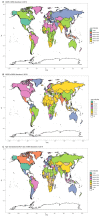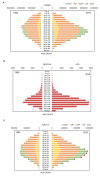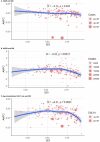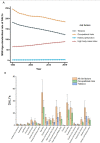Global burden of musculoskeletal disorders and attributable factors in 204 countries and territories: a secondary analysis of the Global Burden of Disease 2019 study
- PMID: 35768100
- PMCID: PMC9244680
- DOI: 10.1136/bmjopen-2022-062183
Global burden of musculoskeletal disorders and attributable factors in 204 countries and territories: a secondary analysis of the Global Burden of Disease 2019 study
Abstract
Objective: To evaluate the global burden of musculoskeletal (MSK) disorders, as well as the five common conditions, and their relevant risk factors from 1990 to 2019.
Design: Data from the Global Burden of Disease Study 2019 were used in this study.
Setting and participants: Individuals of all ages and genders from 204 countries and territories in 21 regions.
Main outcome measures: The outcomes were the numbers and age-standardised rates (ASRs) of incident cases, deaths and disability-adjusted life-years (DALYs) of MSK disorders. The average annual percent changes (AAPCs) in the ASRs were calculated using joinpoint regression analysis to estimate the trends.
Results: There were 322.75 million incident cases, 117.54 thousand deaths and 150.08 million DALYs of MSK disorders in 2019. The age-standardised incidence rate and age-standardised DALY rate in 2019 (incidence: AAPC=-0.32, 95% CI -0.34 to -0.31; DALYs: AAPC=-0.05, 95% CI -0.06 to -0.04) were lower than those in 1990. However, the age-standardised death rate showed a stable trend (AAPC 0.05, 95% CI -0.05 to 0.15) from 1990 to 2019. The peak age of onset and DALYs of MSK disorders was 50-54 years in 2019. The burden of MSK disorders in females was much higher than that in males (1.29 times more incident cases, 2.24 times more deaths and 1.45 times more DALYs in females than in males). A significant negative correlation was observed between the AAPCs in the ASRs and the Sociodemographic Index (SDI) score. Occupational risk exhibited the highest contribution to MSK disorders, and tobacco use and high body mass index were also major risk factors.
Conclusions: This study demonstrates that the burden of MSK disorders tends to be lower in high-SDI regions than in lower-SDI regions. Strengthening the effectiveness of preventive measures against occupational risks may reduce the burden of MSK disorders.
Keywords: epidemiology; musculoskeletal disorders; public health.
© Author(s) (or their employer(s)) 2022. Re-use permitted under CC BY-NC. No commercial re-use. See rights and permissions. Published by BMJ.
Conflict of interest statement
Competing interests: None declared.
Figures




Similar articles
-
The burden of musculoskeletal disorders in the Middle East and North Africa (MENA) region: a longitudinal analysis from the global burden of disease dataset 1990-2019.BMC Musculoskelet Disord. 2023 May 31;24(1):439. doi: 10.1186/s12891-023-06556-x. BMC Musculoskelet Disord. 2023. PMID: 37259119 Free PMC article.
-
Global, regional, and national burdens of early onset pancreatic cancer in adolescents and adults aged 15-49 years from 1990 to 2019 based on the Global Burden of Disease Study 2019: a cross-sectional study.Int J Surg. 2024 Apr 1;110(4):1929-1940. doi: 10.1097/JS9.0000000000001054. Int J Surg. 2024. PMID: 38215264 Free PMC article.
-
Pattern and trend of five major musculoskeletal disorders in China from 1990 to 2017: findings from the Global Burden of Disease Study 2017.BMC Med. 2021 Feb 4;19(1):34. doi: 10.1186/s12916-021-01905-w. BMC Med. 2021. PMID: 33536019 Free PMC article.
-
Global, regional, and national burden of respiratory tract cancers and associated risk factors from 1990 to 2019: a systematic analysis for the Global Burden of Disease Study 2019.Lancet Respir Med. 2021 Sep;9(9):1030-1049. doi: 10.1016/S2213-2600(21)00164-8. Epub 2021 Aug 16. Lancet Respir Med. 2021. PMID: 34411511 Free PMC article.
-
Global, regional, and national burden of 12 mental disorders in 204 countries and territories, 1990-2019: a systematic analysis for the Global Burden of Disease Study 2019.Lancet Psychiatry. 2022 Feb;9(2):137-150. doi: 10.1016/S2215-0366(21)00395-3. Epub 2022 Jan 10. Lancet Psychiatry. 2022. PMID: 35026139 Free PMC article.
Cited by
-
Strategies to optimise the health equity impact of digital pain self-reporting tools: a series of multi-stakeholder focus groups.Int J Equity Health. 2024 Nov 11;23(1):233. doi: 10.1186/s12939-024-02299-w. Int J Equity Health. 2024. PMID: 39529006 Free PMC article.
-
Abnormality in field physical test predicts a reduced quadriceps strength in patients with hip- or knee-osteoarthritis. A prospective observational study.PLoS One. 2024 Dec 27;19(12):e0314524. doi: 10.1371/journal.pone.0314524. eCollection 2024. PLoS One. 2024. PMID: 39729442 Free PMC article.
-
The Prevalence and Work-Related Risk Factors of Musculoskeletal Disorders Among Miners at Kalumbila Mine, Kalumbila District Zambia: A Cross-Sectional Study.Health Sci Rep. 2025 Jun 11;8(6):e70907. doi: 10.1002/hsr2.70907. eCollection 2025 Jun. Health Sci Rep. 2025. PMID: 40510532 Free PMC article.
-
Socioeconomic and lifestyle factors associated with chronic musculoskeletal disorders in Brazil: a network analysis of a population-based study involving 87,648 Brazilian adults.Ther Adv Chronic Dis. 2025 Jun 30;16:20406223251350884. doi: 10.1177/20406223251350884. eCollection 2025. Ther Adv Chronic Dis. 2025. PMID: 40599678 Free PMC article.
-
Social determinants and work-related musculoskeletal disorders in Brazil.PLoS One. 2024 Jul 15;19(7):e0306840. doi: 10.1371/journal.pone.0306840. eCollection 2024. PLoS One. 2024. PMID: 39008458 Free PMC article.
References
Publication types
MeSH terms
LinkOut - more resources
Full Text Sources
Medical
